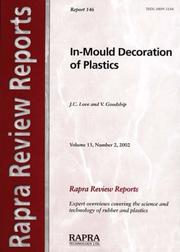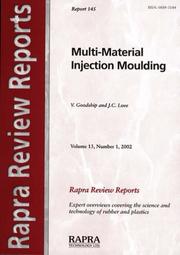| Listing 1 - 2 of 2 |
Sort by
|

ISBN: 1281774839 9786611774837 185957422X 9781859574225 9781859573280 9781859574225 1859573282 9781281774835 6611774831 Year: 2002 Publisher: Shawbury, U.K. Rapra Technology Ltd.
Abstract | Keywords | Export | Availability | Bookmark
 Loading...
Loading...Choose an application
- Reference Manager
- EndNote
- RefWorks (Direct export to RefWorks)
Many plastic components need to have a surface finish applied before use. This can act as a decorative layer, a protective layer, to smooth out surface defects, or to alter surface properties (for example, to enhance adhesion). If this surface effect is applied during the moulding process, it can reduce time, space, material and machinery requirements. It also allows processors to supply complete systems, rather than just moulded components. In-mould decoration techniques include the in-mould application of film, in-mould priming, in-mould labelling and the injection of paints into the mould.
Manufacturing processes. --- Plastics. --- Plastic materials --- Plastic products --- Polymers --- Synthetic products --- Condensation products (Chemistry) --- Elastomers --- Plasticity --- Industrial processing --- Manufacture --- Process engineering (Manufactures) --- Processes, Manufacturing --- Processing, Industrial --- Production processes --- Industrial arts --- Production engineering --- Machine-tools --- Materials

ISBN: 1281774790 9786611774790 1859574211 9781859574218 9781859573273 9781859574218 1859573274 9781281774798 6611774793 Year: 2002 Publisher: Shrewsbury, U.K. Rapra Technology
Abstract | Keywords | Export | Availability | Bookmark
 Loading...
Loading...Choose an application
- Reference Manager
- EndNote
- RefWorks (Direct export to RefWorks)
Injection moulding is the most important of all the commercial methods of plastics processing. Many variations have been developed and one of the rapidly expanding fields is multi-material injection moulding. This is particularly important where processors are looking to gain technological advantages over rivals by adding value to products. Whilst tooling costs can be very high, cost savings can be made by eliminating assembly steps. This review looks at the many techniques being used, from the terminology to case studies. There are many issues involved in moulding different types of materials
Injection molding of plastics. --- Industrial processes. --- Plastics. --- Plastic materials --- Plastic products --- Polymers --- Synthetic products --- Condensation products (Chemistry) --- Elastomers --- Plasticity --- Plastics --- Molding
| Listing 1 - 2 of 2 |
Sort by
|

 Search
Search Feedback
Feedback About UniCat
About UniCat  Help
Help News
News